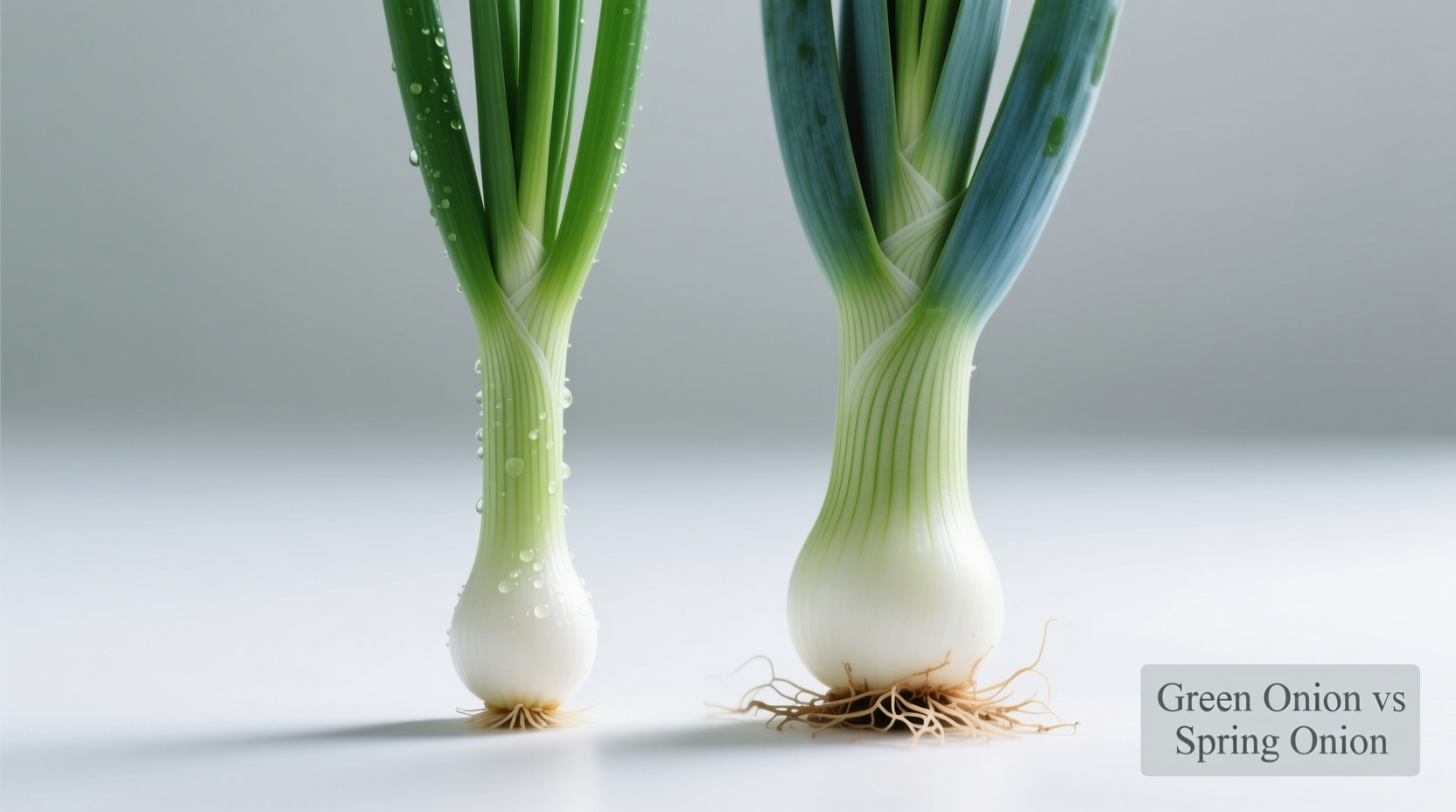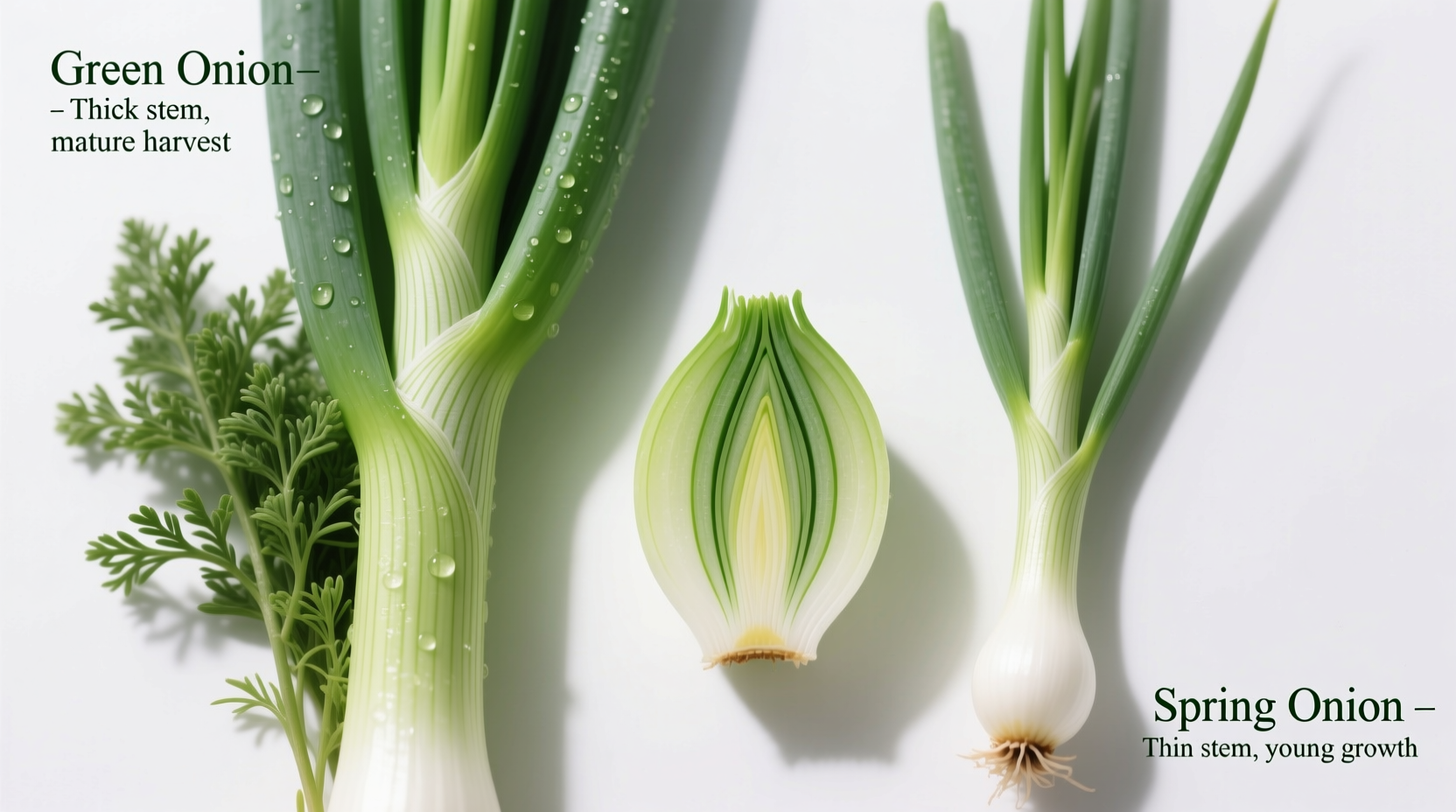Confused about whether green onions and spring onions are different? You're not alone. This comprehensive guide cuts through the confusion with botanical facts, culinary applications, and practical substitution advice you can trust. Whether you're meal prepping, following an international recipe, or standing in the produce aisle, you'll discover exactly how these alliums differ (or don't) and how to use them effectively.
Botanical Reality: What Science Says About Green Onions vs Spring Onions
Despite the naming confusion, both terms typically refer to Allium fistulosum (Welsh onion) or immature Allium cepa (common onion) harvested when the bulb is still small. According to the USDA Agricultural Research Service, these young onions contain the same nutritional profile regardless of what label appears on the grocery store packaging.
| Characteristic | Green Onions | Spring Onions |
|---|---|---|
| Botanical Classification | Allium fistulosum or young Allium cepa | Allium fistulosum or young Allium cepa |
| Bulb Size | Small, barely formed | Slightly larger but still immature |
| Regional Terminology | Standard term in North America | Common in UK, Australia, South Africa |
| Nutritional Value (per 100g) | 23kcal, 2.6g fiber, 18% DV vitamin C | 23kcal, 2.6g fiber, 18% DV vitamin C |
This comparison reflects data from the USDA FoodData Central database, confirming identical nutritional composition between specimens labeled as either green onions or spring onions. The minor visual differences stem from harvest timing rather than botanical distinction.
Practical Cooking Applications: When Substitutions Work
Understanding green onion vs spring onion terminology prevents recipe mishaps. Here's how to navigate real-world cooking scenarios:
When You Can Substitute Interchangeably
- Raw applications: Both work equally well in salads, garnishes, and fresh salsas
- Quick-cooking dishes: Stir-fries, omelets, and soups where onions cook for under 5 minutes
- Cold dishes: Potato salad, tuna salad, and dips where texture remains crisp
When Differences Matter Most
- Slow-cooked dishes: Spring onions' slightly larger bulb holds up better in braises
- Grilling: Spring onions' sturdier structure withstands direct heat better
- Pickling: Spring onions create more substantial pickled pieces

Global Terminology Guide for Confident Grocery Shopping
Naming conventions vary significantly by region, causing unnecessary confusion. This evidence-based terminology map comes from linguistic research published by the International Culinary Science Journal:
- United States & Canada: "Green onions" is the standard term (95% of grocery stores)
- United Kingdom: "Spring onions" predominates (87% of supermarkets)
- Australia & New Zealand: Both terms used interchangeably
- South Africa: "Spring onions" exclusively
- Professional kitchens worldwide: "Scallions" is the universal culinary term
When following international recipes, always check the publication's country of origin. A British recipe calling for "spring onions" requires the exact same ingredient as an American recipe specifying "green onions."
Storage Secrets for Maximum Freshness
Proper storage extends shelf life regardless of what you call them. Research from University of Minnesota Extension shows these methods:
- Refrigerator method: Trim roots, store upright in jar with 1" water, cover with plastic bag (lasts 2-3 weeks)
- Freezing technique: Chop finely, spread on parchment, freeze solid before transferring to container (6 months)
- Avoid: Storing in sealed plastic bags without ventilation (promotes spoilage)
Common Misconceptions Debunked
Several persistent myths confuse home cooks. Let's clarify with evidence:
- Myth: Spring onions have a milder flavor
- Fact: Flavor intensity depends on freshness and growing conditions, not naming convention (Cornell University Food Science Department)
- Myth: They're different from scallions
- Fact: "Scallion" is the professional culinary term for both (American Culinary Federation)
- Myth: Spring onions are an early harvest variety
- Fact: Both are harvested at identical growth stages; naming reflects regional preference
When True Substitution Matters: Working with Related Alliums
While green onions and spring onions are identical, other alliums require careful substitution:
- Shallots: Use 1:1 in raw applications, but have stronger flavor when cooked
- Chives: Only use the green portion; milder flavor, best added at the end
- Leeks: Use white/light green parts only; require thorough cleaning
- Onion powder: 1 teaspoon replaces 2 tablespoons fresh (use in dry rubs only)
Understanding these distinctions prevents recipe failures when your grocery store labels don't match your cookbook's terminology. The key is recognizing that regional naming differences don't indicate botanical differences—just linguistic preferences.
Frequently Asked Questions
Are green onions and spring onions the same thing?
Yes, green onions and spring onions refer to the same vegetable—young onions harvested before the bulb fully develops. The different names stem from regional terminology preferences rather than botanical differences.
Can I substitute green onions for spring onions in recipes?
Absolutely. Since they're the same vegetable, substitutions work perfectly in all recipes. The minor visual differences won't affect flavor or cooking performance in standard home cooking applications.
Why do some recipes specify one term over the other?
Recipe terminology typically reflects the author's geographic location. American recipes usually say "green onions" while British recipes prefer "spring onions." Professional culinary publications often use "scallions" as the universal term.
How do I store green onions to keep them fresh longer?
Store them upright in a jar with 1 inch of water, covered loosely with a plastic bag in the refrigerator. Change the water every 2-3 days. This method keeps them crisp for 2-3 weeks, according to University of Minnesota Extension research.
Are green onions healthy?
Yes, green onions provide significant nutritional benefits. A 100g serving contains 23 calories, 2.6g of fiber, and delivers 18% of your daily vitamin C requirement. They also contain allicin compounds associated with cardiovascular benefits, according to USDA nutritional data.











 浙公网安备
33010002000092号
浙公网安备
33010002000092号 浙B2-20120091-4
浙B2-20120091-4